Research on Seismic Performance and Reinforcement Methods for Self-Centering Rocking Steel Bridge Piers
Abstract
:1. Introduction
2. Self-Centering Rocking Steel Bridge Pier Structure and Its Finite Element Analysis Model
2.1. The Form and Design Parameters of the Structure
2.2. Finite Element Analysis Model and Verification
3. Comparison of Seismic Performance between Concrete-Filled Rocking Steel Bridge Piers and Hollow Rocking Steel Bridge Piers
4. The Influence of Overall Design Parameters of Bridge Piers on the Seismic Performance of Rocking Steel Bridge Piers
4.1. Self-Centering Index
4.2. Prestressing Ratio
4.3. Base Plate Thickness Increase Factor
4.4. Base Plate Radius Increase Factor
4.5. Axial Compression Ratio
4.6. Slenderness Ratio
4.7. Radius-to-Thickness Ratio
5. Seismic Strengthening Mechanism Analysis of the Plastic Region
6. Conclusions
Author Contributions
Funding
Institutional Review Board Statement
Informed Consent Statement
Data Availability Statement
Conflicts of Interest
References
- Chen, W.F.; Duan, L. Bridge Engineering Handbook: Seismic Design, 2nd ed.; Taylor & Francis Group: Boca Raton, FL, USA; London, UK; New York, NY, USA, 2014. [Google Scholar]
- Li, J.Z.; Guan, Z.G. Research progress on bridge seismic design: Target from seismic alleviation to post-earthquake structural resilience. China J. Highw. Transp. 2017, 30, 1–9. [Google Scholar]
- Yuan, W.C.; Wang, S.J.; Li, H.F.; He, J.-h.; Dang, X.-z. Development of intelligence and resilience for bridge seismic design. China J. Highw. Transp. 2021, 34, 98–117. [Google Scholar]
- Mander, J.B.; Cheng, C.T. Seismic Resistance of Bridge Piers Based on Damage Avoidance Design; US National Center for Earthquake Engineering Research (NCEER): New York, NY, USA, 1997. [Google Scholar]
- Pampanin, S.; Priestley, M.J.N.; Sritharan, S. Analytical modelling of the seismic behaviour of precast concrete frames designed with ductile connections. J. Earthq. Eng. 2001, 5, 329–367. [Google Scholar] [CrossRef]
- Palermo, A. The Use of Controlled Rocking in the Seismic Design of Bridges. Ph.D. Thesis, Technical University of Milan, Milan, Italy, 2004. [Google Scholar]
- Palermo, A.; Pampanin, S.; Marriott, D. Design, modeling, and experimental response of seismic resistant bridge piers with posttensioned dissipating connections. J. Struct. Eng. 2007, 133, 1648–1661. [Google Scholar] [CrossRef]
- Marriott, D.; Pampanin, S.; Palermo, A. Quasi-static and pseudo-dynamic testing of unbonded post-tensioned rocking bridge piers with external replaceable dissipaters. Earthq. Eng. Struct. Dyn. 2009, 38, 331–354. [Google Scholar] [CrossRef]
- Zhang, D.; Li, N.; Li, Z.X.; Xie, L. Seismic Performance of bridge with unbonded posttensioned self-centering segmental concrete filled steel tube columns: An underwater shaking table test. Soil Dyn. Earthq. Eng. 2020, 138, 106350. [Google Scholar] [CrossRef]
- Guo, T.; Cao, Z.L.; Xu, Z.K.; Lu, S. Cyclic load tests on self-centering concrete pier with external dissipators and enhanced durability. J. Struct. Eng. 2016, 142, 04015088. [Google Scholar] [CrossRef]
- Roh, H.; Reinhorn, A.M. Hysteretic behavior of precast segmental bridge piers with superelastic shape memory alloy bars. Eng. Struct. 2010, 32, 3394–3403. [Google Scholar] [CrossRef]
- Han, Q.; Jia, Z.L.; Xu, K. Hysteretic behavior investigation of self-centering double-column rocking piers for seismic resilience. Eng. Struct. 2019, 188, 218–232. [Google Scholar] [CrossRef]
- Liu, X.S.; Li, J.Z.; Zhang, H.J.; Chen, Z.Y. Experimental analysis of seismic performance of precast assembled concrete filled steel tube piers under different structures. China J. Highw. Transp. 2021, 34, 116–128. [Google Scholar]
- Wang, Z.F.; Zhang, X.; Hou, W.Y.; Yu, F.L. Seismic and recovery performance of concrete-filled steel tube piers with self-centering function. J. Shenyang Jianzhu Univ. (Nat. Sci.) 2022, 38, 75–83. [Google Scholar]
- Jia, J.F.; Zhao, J.Y.; Zhang, Q.; Qi, L.; Han, Q.; Du, X. Experiment on lateral bearing behavior of post-tensioned segmental CFST bridge pier columns. China J. Highw. Transp. 2017, 30, 236–245. [Google Scholar]
- Lu, S.C. Pseudo Static Model Test and Pushover Analysis of Self-Centering Controlled Rocking Steel-Concrete Composite Pier. Master’s Thesis, Lanzhou Jiaotong University, Lanzhou, China, 2019. [Google Scholar]
- Chen, S.X.; Xie, X.; Zhuge, H.Q. Hysteretic model for steel piers considering the local buckling of steel plates. Eng. Struct. 2019, 183, 303–318. [Google Scholar] [CrossRef]
- Zhuge, H.Q.; Xie, X.; Tang, Z.Z. Lengths of damaged zones of steel piers under bidirectional horizontal earthquake components. China J. Highw. Transp. 2019, 32, 79–90. [Google Scholar]
- Zhuge, H.Q.; Xie, X.; Li, S.L.; Wang, J.D. Seismic performance test and practical calculation method of thin-walled square-section steel piers under horizontal bi-directional seismic excitations. China Civ. Eng. J. 2020, 53, 74–85. [Google Scholar]
- Zhuge, H.Q.; Xie, X.; Chen, S.X.; Tang, Z. Research on the multi-shear spring model for circular-section steel piers. J. Constr. Steel Res. 2022, 188, 107041. [Google Scholar] [CrossRef]
- Li, S.L.; Lin, J.H.; Zhuge, H.Q.; Xie, X.; Cheng, C. Ultra-low cycle fatigue fracture initiation life evaluation of thick-walled steel bridge piers with microscopic damage index under bidirectional cyclic loading. Structures 2022, 43, 669–681. [Google Scholar] [CrossRef]
- Jiang, K.P.; Li, H.F.; Zhao, X.H.; Zheng, S.-J. Seismic behavior of portal box-shaped steel pier with embedded energy-dissipating steel plates. Eng. Mech. 2022, 39, 200–213. [Google Scholar]
- Rahmzadeh, A.; Alam, M.S.; Tremblay, R. Analytical prediction and finite-element simulation of the lateral response of rocking steel bridge piers with energy-dissipating steel bars. J. Struct. Eng. 2018, 144, 04018210. [Google Scholar] [CrossRef]
- Rahmzadeh, A.; Alam, M.S.; Tremblay, R. Experimental investigations on the lateral cyclic response of post-tensioned rocking steel bridge piers. J. Struct. Eng. 2021, 147, 04021211. [Google Scholar] [CrossRef]
- Rahmzadeh, A.; Alam, M.S.; Tremblay, R. Finite-element simulation of the lateral response of posttensioned base rocking steel bridge piers. J. Struct. Eng. 2022, 148, 04022141. [Google Scholar] [CrossRef]
- Bao, Z.H.; Li, J.Z.; Li, Y.X.; Zhong, X.Q. Research on the design method of reasonable reinforcement ratio of energy-dissipation bars in self-centering columns. Eng. Mech. 2022, 39, 88–89. [Google Scholar]
- Zheng, Y.; Usami, T.; Ge, H.B. Ductility evaluation procedure for thin-walled steel structures. J. Struct. Eng. 2000, 126, 1312–1319. [Google Scholar] [CrossRef]
- Goto, Y.; Ghosh, P.K.; Kawanishi, N. Nonlinear finite element analysis for hysteretic behavior of thin-walled circular steel columns with in-filled concrete. J. Struct. Eng. 2010, 136, 1413–1422. [Google Scholar] [CrossRef]
- Wang, T. Improvement of Hysteretic Constitutive Model for Bridge Structural Steels and Its Application. Ph.D. Thesis, Zhejiang University, Hangzhou, China, 2016. [Google Scholar]


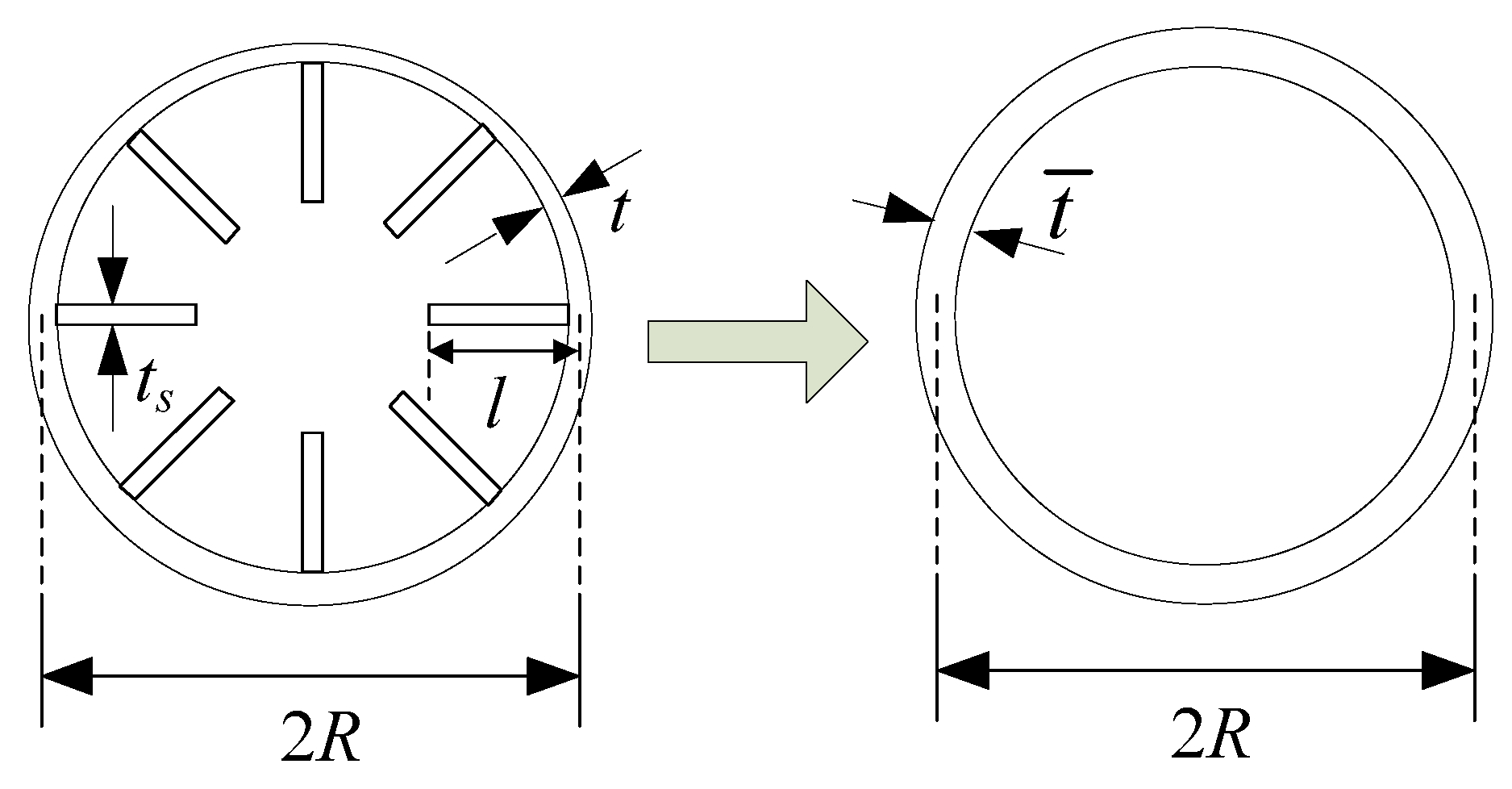

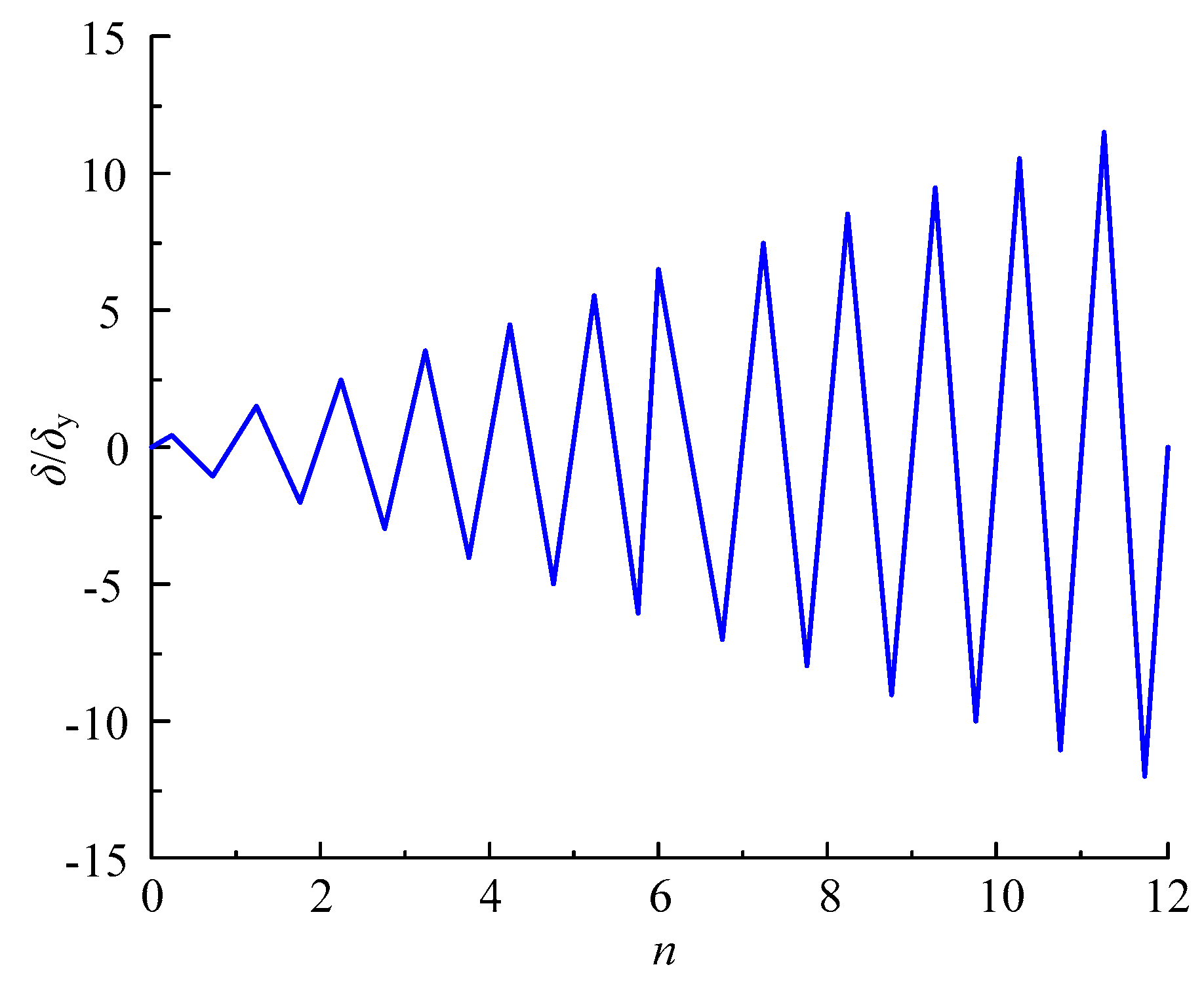

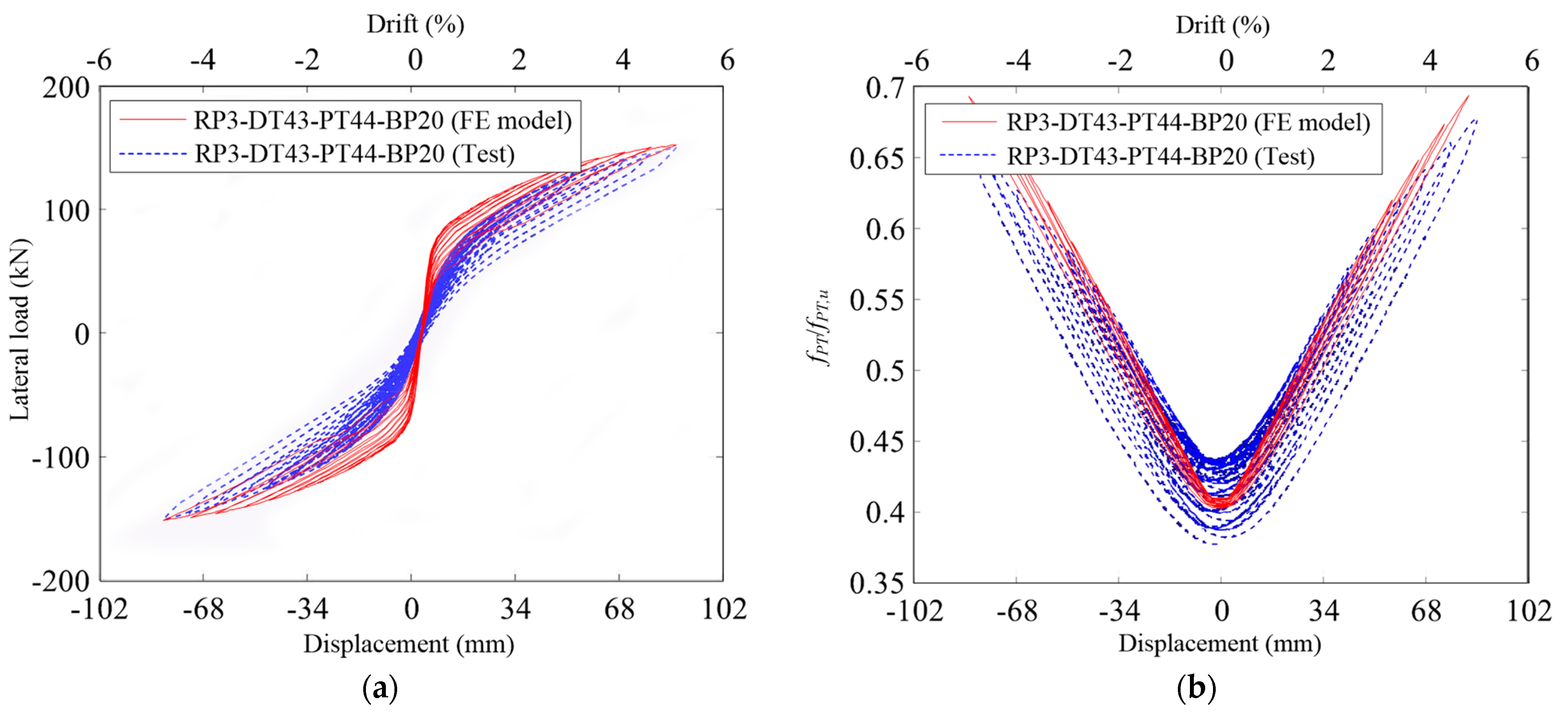
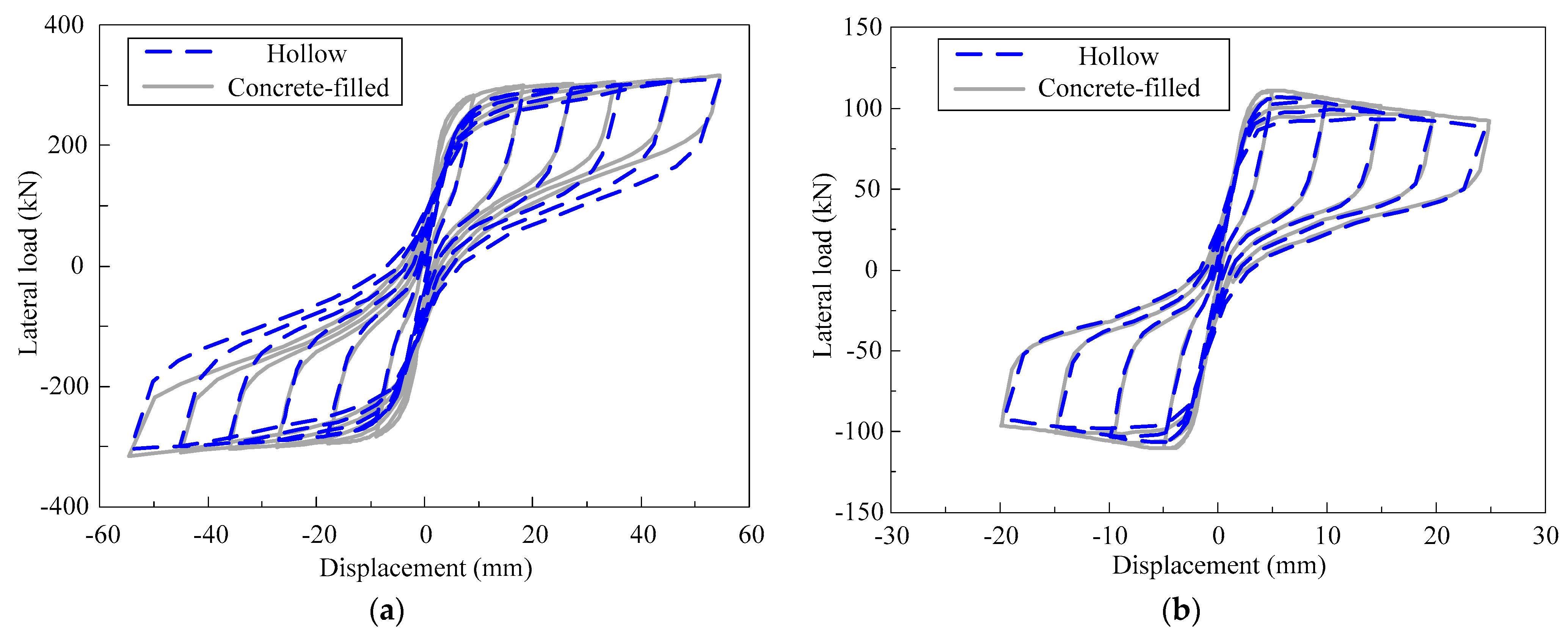

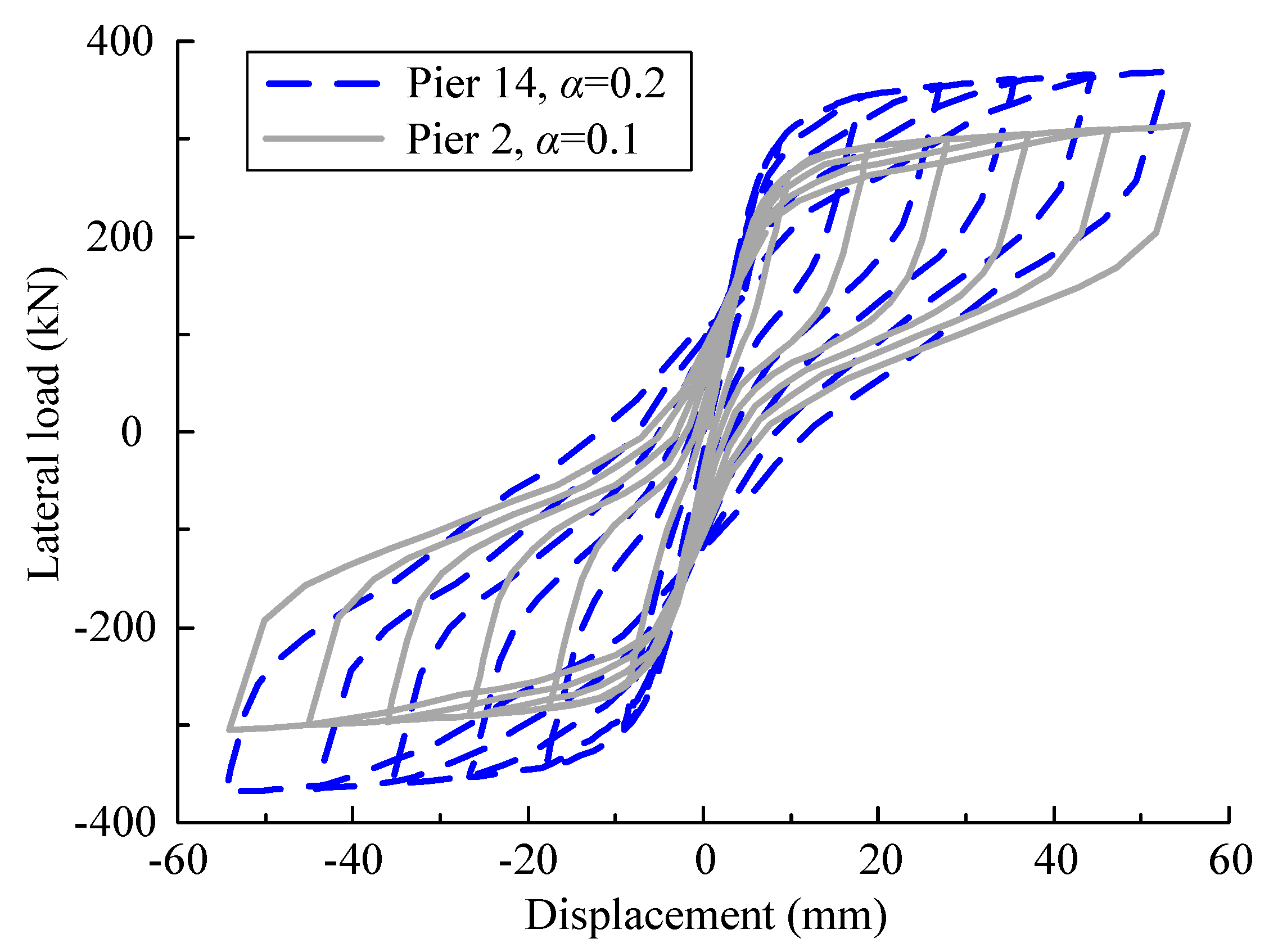

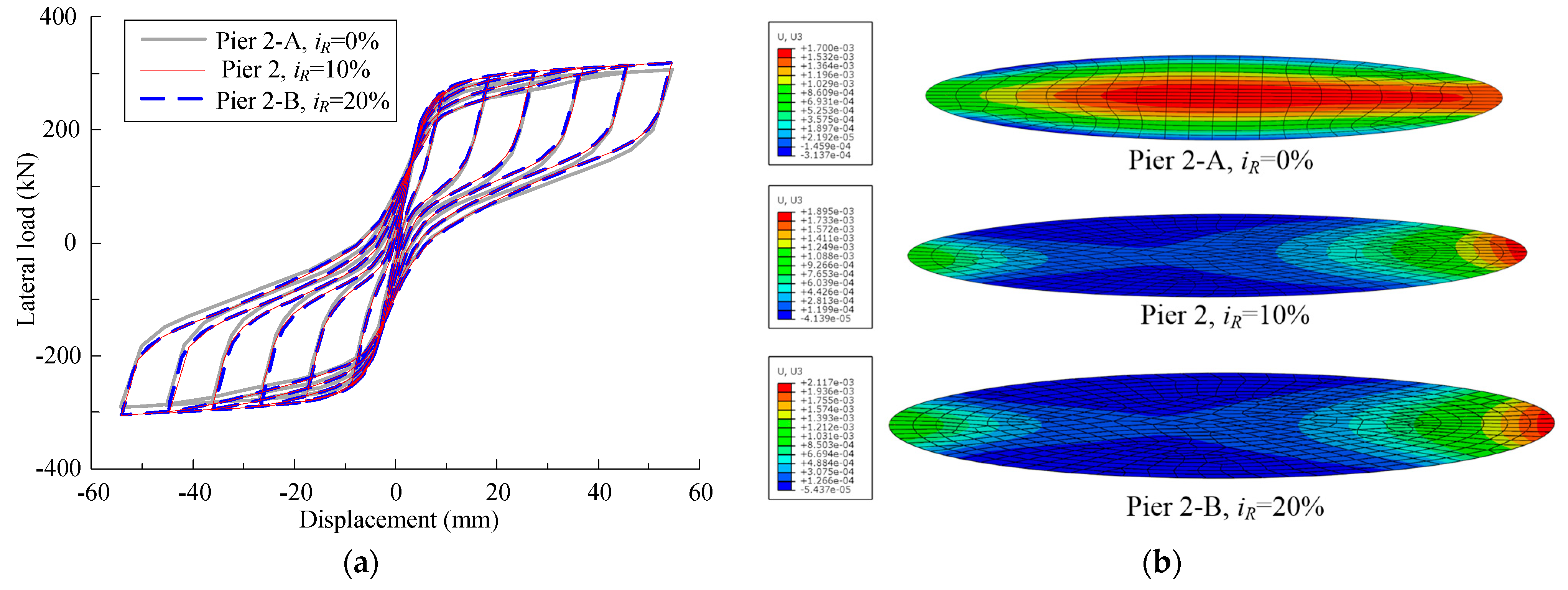
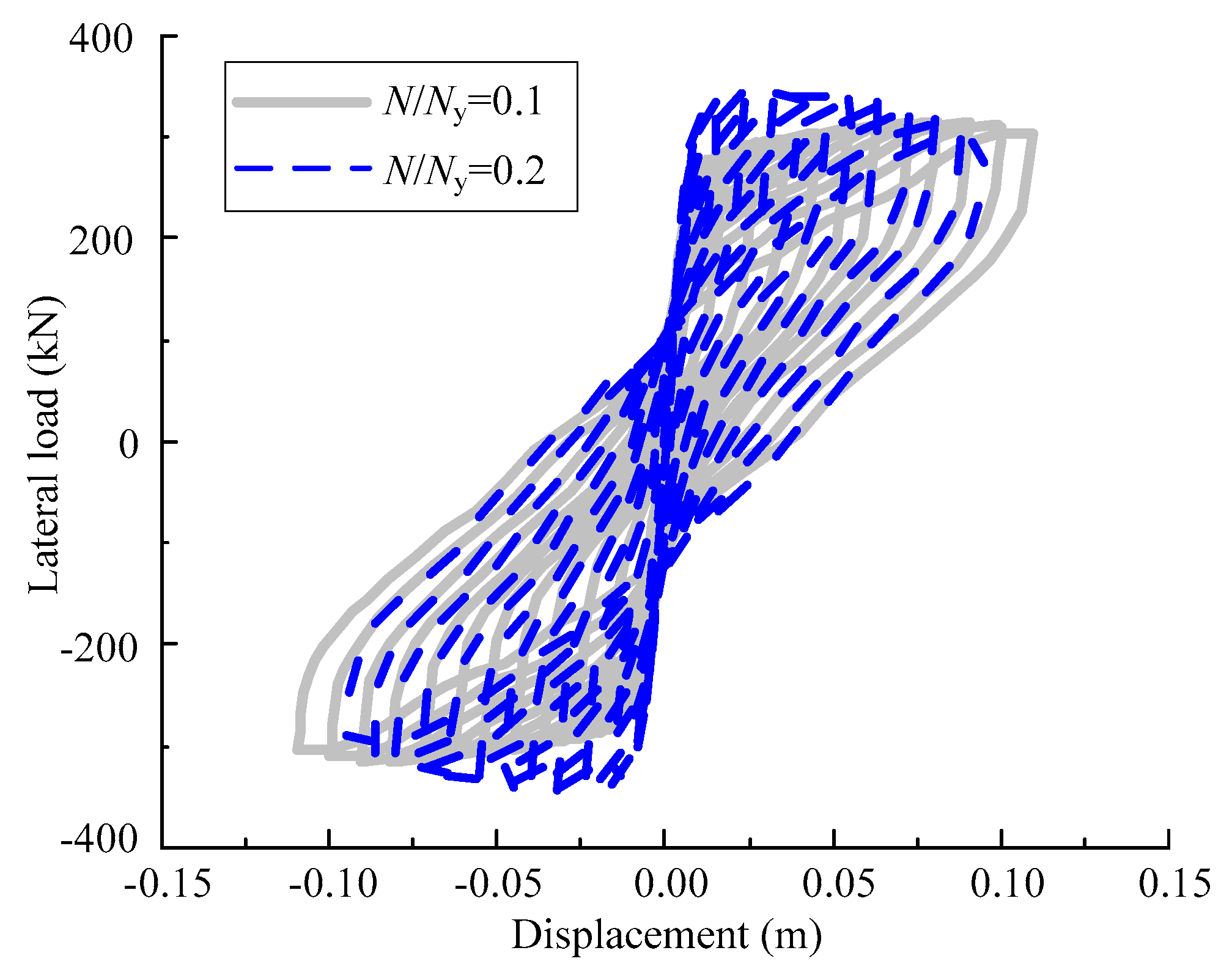
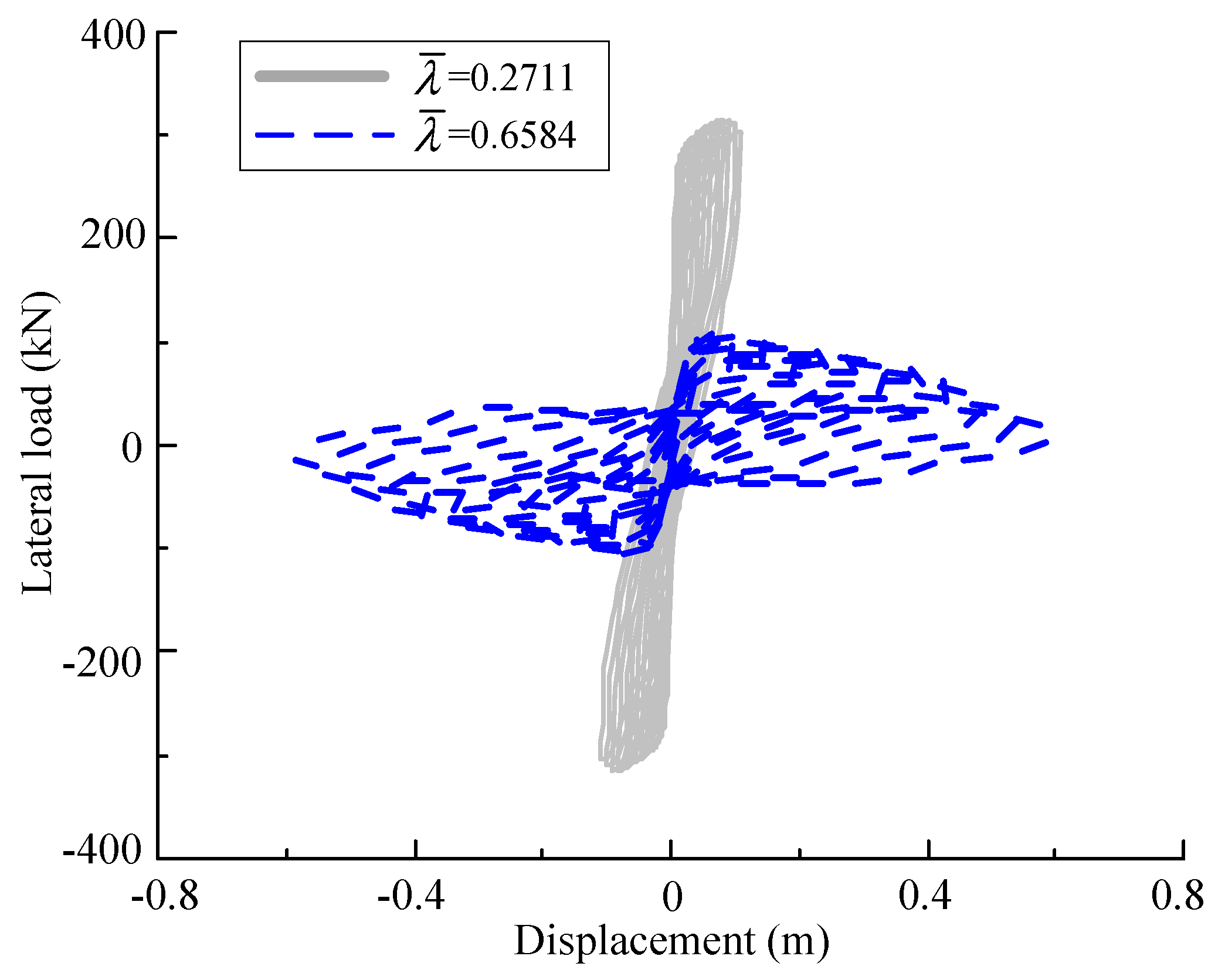

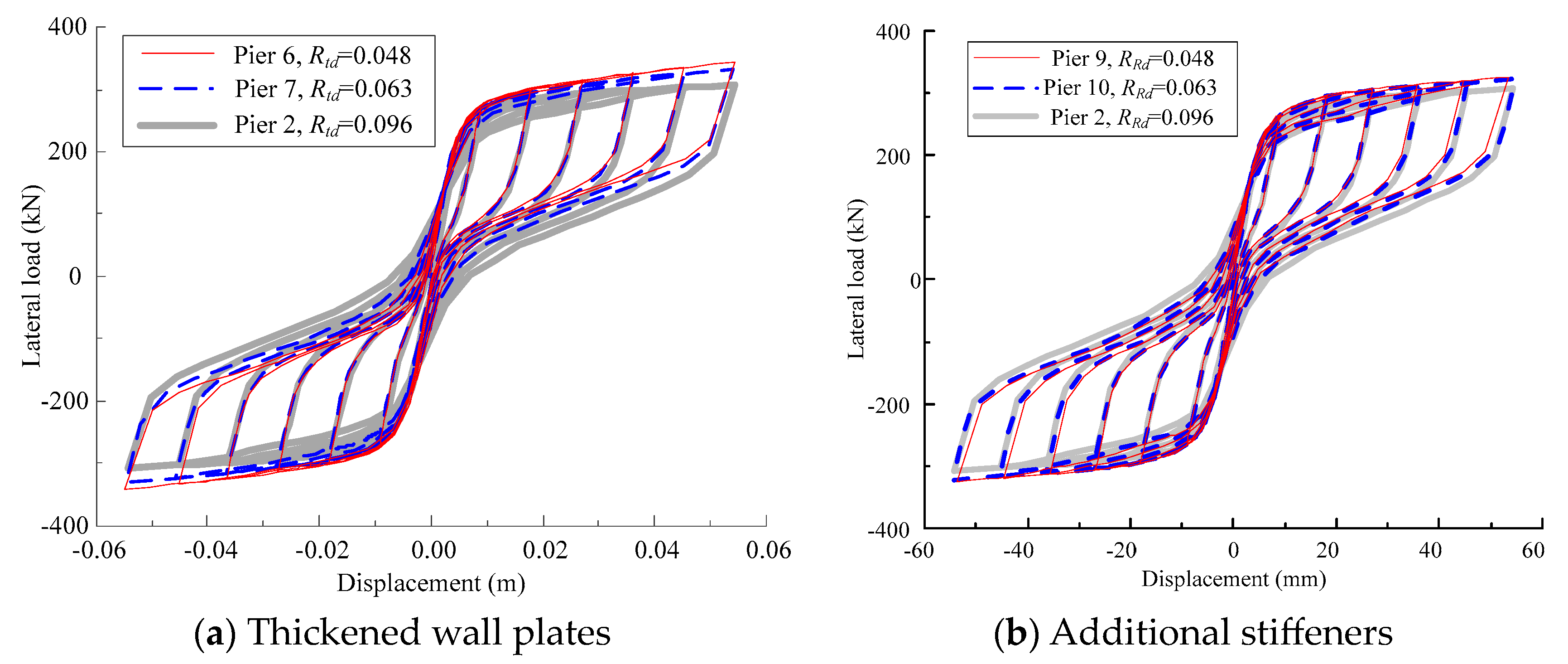

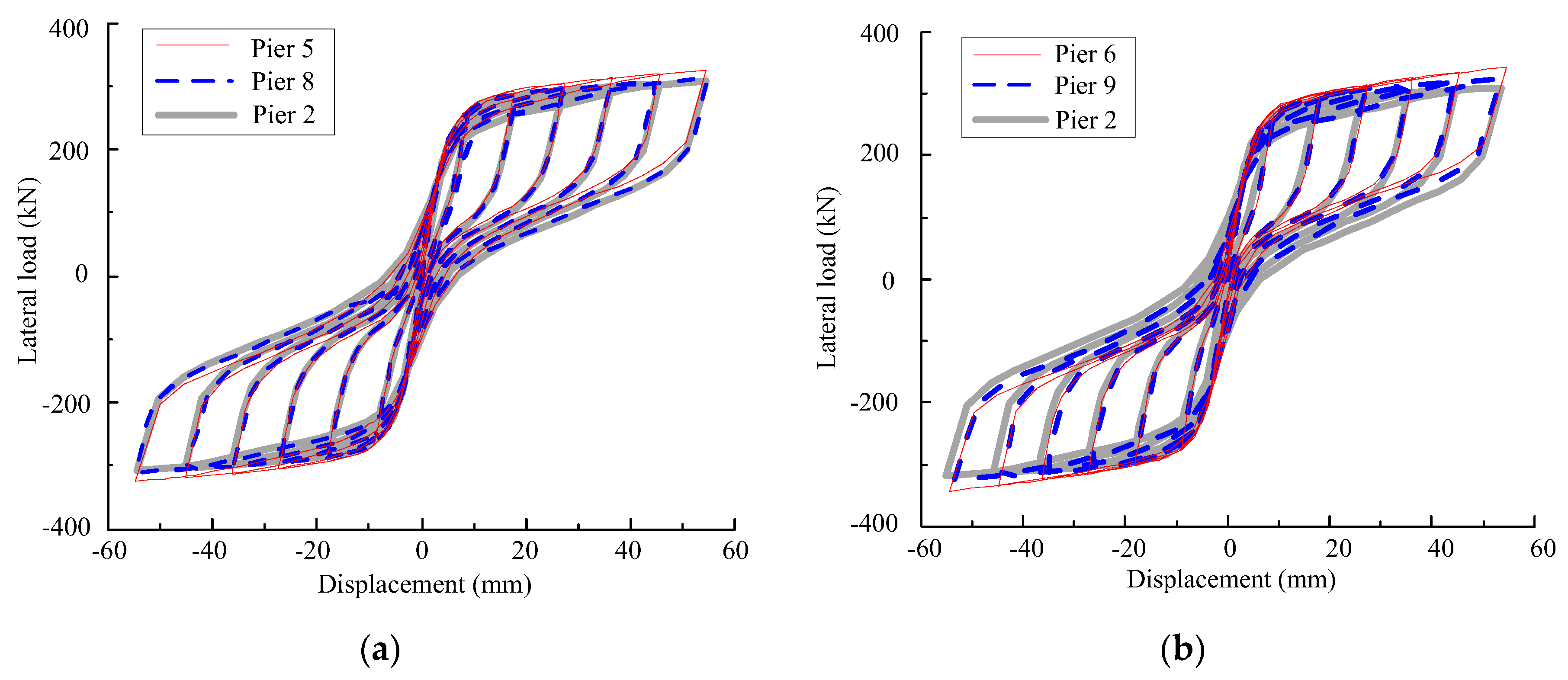

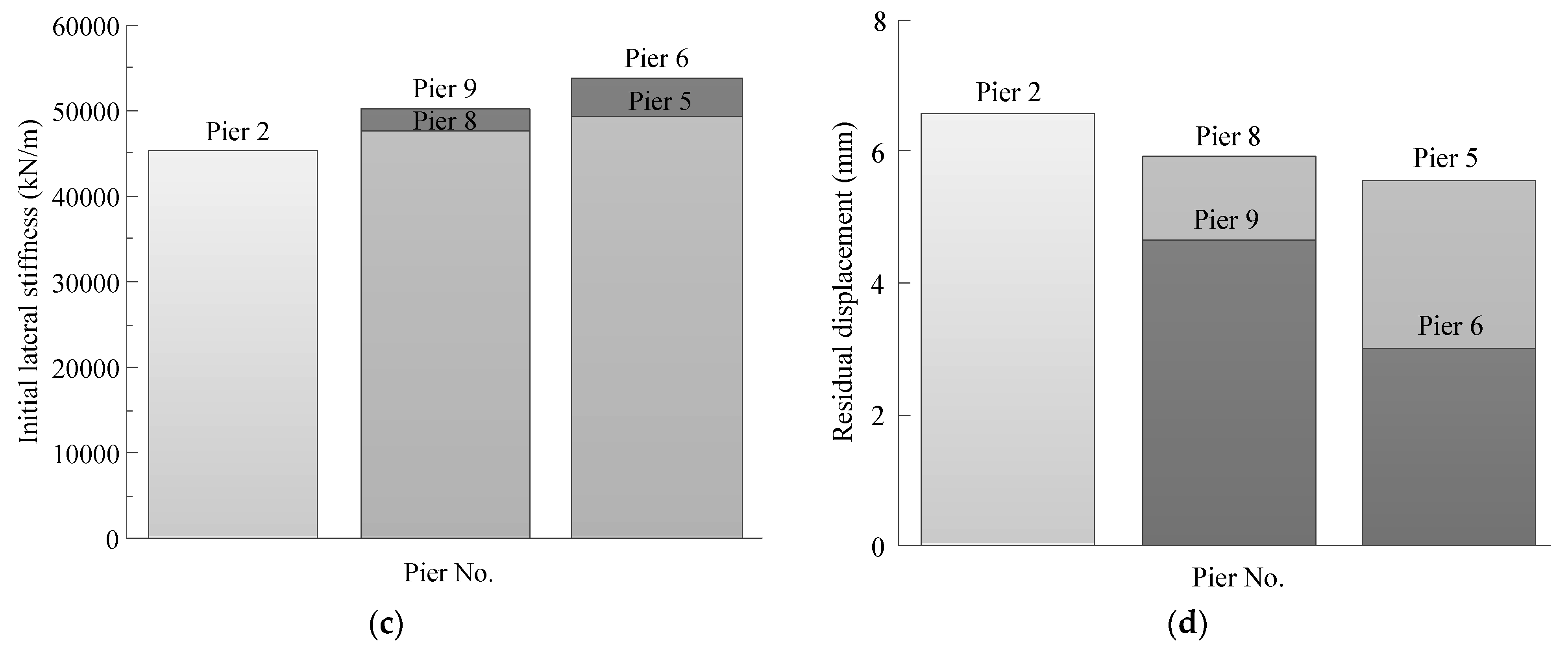
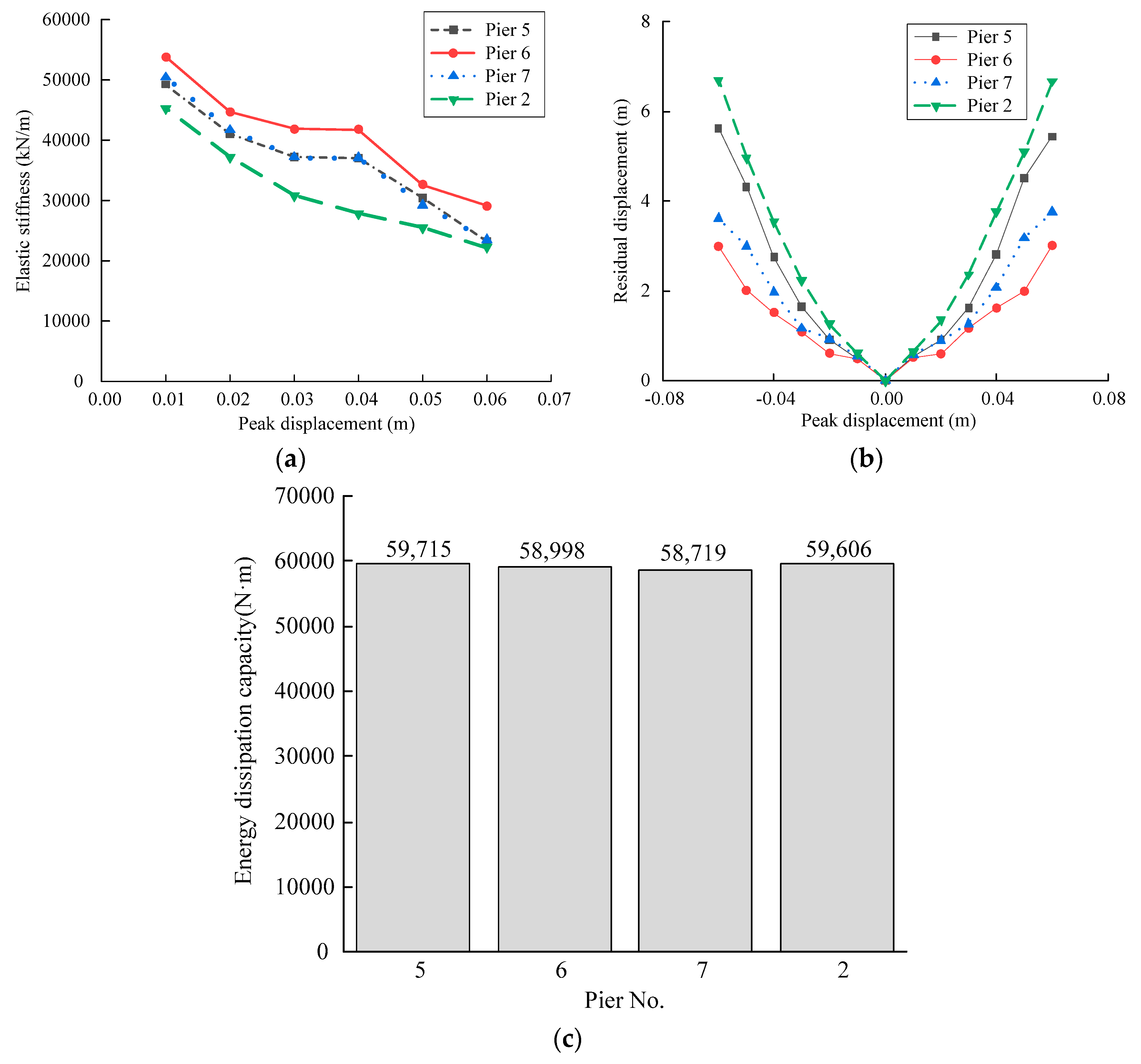
| No. | R × t × h (mm) | Rt | N/Ny | it (%) | iR (%) | α | λ | Reinforcement Method | Rtd | ld (m) | |
|---|---|---|---|---|---|---|---|---|---|---|---|
| 1 | 305 × 10 × 2100 | 0.096 | 0.2711 | 0.10 | 0 | 10 | 0.10 | 1.763 | / | 0.096 | / |
| 2-A | 305 × 10 × 2100 | 0.096 | 0.2711 | 0.10 | 100 | 0 | 0.10 | 1.763 | / | 0.096 | / |
| 2 | 305 × 10 × 2100 | 0.096 | 0.2711 | 0.10 | 100 | 10 | 0.10 | 1.763 | / | 0.096 | / |
| 2-B | 305 × 10 × 2100 | 0.096 | 0.2711 | 0.10 | 100 | 20 | 0.10 | 1.763 | / | 0.096 | / |
| 3 | 305 × 10 × 2100 | 0.096 | 0.2711 | 0.10 | 200 | 10 | 0.10 | 1.763 | / | 0.096 | / |
| 4 | 305 × 10 × 2100 | 0.096 | 0.2711 | 0.10 | 300 | 10 | 0.10 | 1.763 | / | 0.096 | / |
| 5 | 305 × 10 × 2100 | 0.096 | 0.2711 | 0.10 | 100 | 10 | 0.10 | 1.763 | Thickened wall plate | 0.048 | 0.15 |
| 6 | 305 × 10 × 2100 | 0.096 | 0.2711 | 0.10 | 100 | 10 | 0.10 | 1.763 | Thickened wall plate | 0.048 | 0.30 |
| 7 | 305 × 10 × 2100 | 0.096 | 0.2711 | 0.10 | 100 | 10 | 0.10 | 1.763 | Thickened wall plate | 0.063 | 0.30 |
| 8 | 305 × 10 × 2100 | 0.096 | 0.2711 | 0.10 | 100 | 10 | 0.10 | 1.763 | Additional stiffeners | 0.048 | 0.15 |
| 9 | 305 × 10 × 2100 | 0.096 | 0.2711 | 0.10 | 100 | 10 | 0.10 | 1.763 | Additional stiffeners | 0.048 | 0.30 |
| 10 | 305 × 10 × 2100 | 0.096 | 0.2711 | 0.10 | 100 | 10 | 0.10 | 1.763 | Additional stiffeners | 0.063 | 0.30 |
| 11 | 305 × 10 × 2100 | 0.096 | 0.2711 | 0.20 | 100 | 10 | 0.10 | 1.763 | / | 0.096 | / |
| 12 | 305 × 10 × 5100 | 0.096 | 0.6584 | 0.10 | 100 | 10 | 0.10 | 1.763 | / | 0.096 | / |
| 13 | 305 × 20 × 2100 | 0.048 | 0.2711 | 0.10 | 100 | 10 | 0.10 | 1.763 | / | 0.048 | / |
| 14 | 305 × 10 × 2100 | 0.096 | 0.2711 | 0.10 | 100 | 10 | 0.20 | 1.763 | / | 0.096 | / |
| 15 | 305 × 10 × 2100 | 0.096 | 0.2711 | 0.10 | 100 | 10 | 0.10 | 0.882 | / | 0.096 | / |
| Specimen No. | R × t × h (mm) | Rt | α | λ | N/Ny | it (%) (%) | iR (%) (%) | |
|---|---|---|---|---|---|---|---|---|
| RP3-DT43-PT44-BP20 | 203 × 9.53 × 1677 | 0.071 | 0.335 | 0.162 | 0.0 | 0.0 | 166.5 | 25.1 |
Disclaimer/Publisher’s Note: The statements, opinions and data contained in all publications are solely those of the individual author(s) and contributor(s) and not of MDPI and/or the editor(s). MDPI and/or the editor(s) disclaim responsibility for any injury to people or property resulting from any ideas, methods, instructions or products referred to in the content. |
© 2023 by the authors. Licensee MDPI, Basel, Switzerland. This article is an open access article distributed under the terms and conditions of the Creative Commons Attribution (CC BY) license (https://creativecommons.org/licenses/by/4.0/).
Share and Cite
Zhuge, H.; Niu, C.; Du, R.; Tang, Z. Research on Seismic Performance and Reinforcement Methods for Self-Centering Rocking Steel Bridge Piers. Appl. Sci. 2023, 13, 9108. https://doi.org/10.3390/app13169108
Zhuge H, Niu C, Du R, Tang Z. Research on Seismic Performance and Reinforcement Methods for Self-Centering Rocking Steel Bridge Piers. Applied Sciences. 2023; 13(16):9108. https://doi.org/10.3390/app13169108
Chicago/Turabian StyleZhuge, Hanqing, Chenpeng Niu, Rui Du, and Zhanzhan Tang. 2023. "Research on Seismic Performance and Reinforcement Methods for Self-Centering Rocking Steel Bridge Piers" Applied Sciences 13, no. 16: 9108. https://doi.org/10.3390/app13169108









